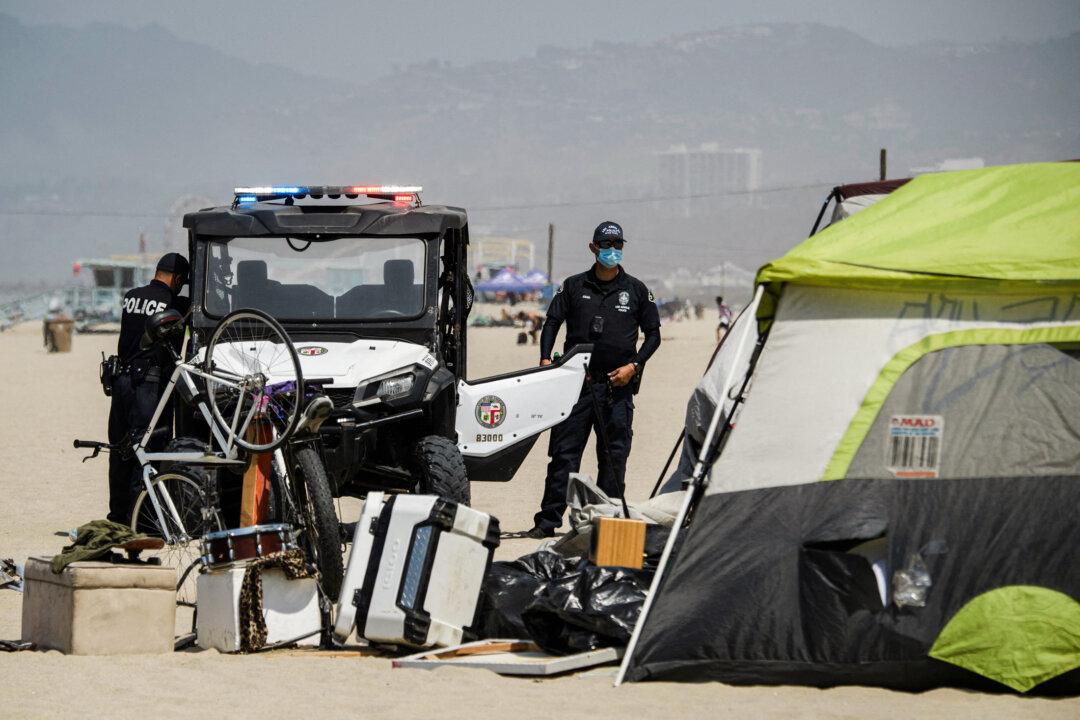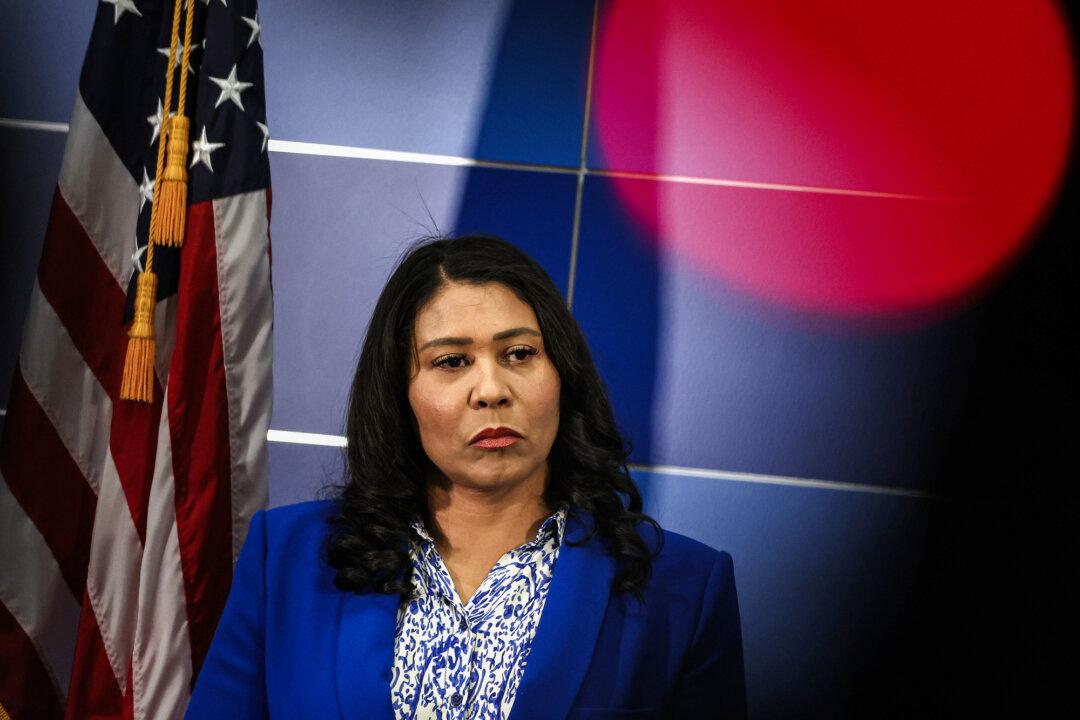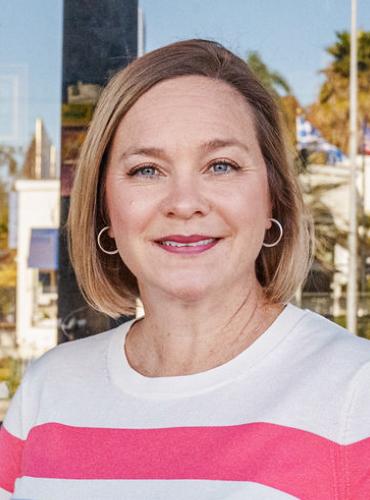LOS ANGELES—In a highly anticipated ruling, the Supreme Court on June 28 held that cities can restrict homeless encampments on public property, overturning lower court rulings that say penalizing people for sleeping outside violated the Eighth Amendment’s prohibition on cruel and unusual punishment.
For local governments, the ruling brought clarity after years of legal limbo, restoring local control over the delicate balance between protecting the rights of homeless people and protecting public safety and health.
But as government officials in California reacted, the scope of continued disagreement became clear, and the picture for California became less so, as local ordinances there are likely to be enforced differently.
“This decision removes the legal ambiguities that have tied the hands of local officials for years and limited their ability to deliver on commonsense measures to protect the safety and well-being of our communities,” California Gov. Gavin Newsom said in a statement.
Activists and many other politicians, meanwhile, condemned it as a shameful criminalization of homelessness—an added cruelty for those who have nowhere else to go.
Los Angeles County Supervisor Lindsey Horvath slammed the decision and vowed to fight or, perhaps, ignore it.
“As the Chair of [the Los Angeles Homeless Services Authority] and the Board of Supervisors I want to be crystal clear: The criminalization of homelessness and poverty is dangerous. It does not work. And it will not stand in Los Angeles County,” Horvath said in a statement.
Benjamin Henwood, director of the Center for Homelessness, Housing and Health Equity Research at the University of Southern California, told The Epoch Times that while “most people saw this coming,” it doesn’t change the underlying political calculus, which includes ideological battles around mental health and addiction treatment and affordable housing.
“If a politician is really getting pressure to clear a specific encampment, yes that can happen easier,” Henwood, who led the Los Angeles Homeless Authority’s 2024 Point-in-Time homeless count, said.
“What remains to be seen, and it’s more of an empirical question, then becomes, does enforcement in one area drive people to other areas? That’s something we’ll see in the data.”
The 2024 homeless count for Los Angeles County, also announced on June 28, shows an estimated 0.27 percent decline in the county’s homeless population to 75,312 and a 2.2 percent decrease in the city of Los Angeles to 45,252.
However, there are outliers within the county, such as Antelope Valley, which saw a 42 percent increase in its overall homeless population since last year.

An encampment of homeless people in the Skid Row community in Los Angeles on June 28, 2024. (Mario Tama/Getty Images)
Like Santa Monica and Long Beach, Antelope Valley is an “end-of-line” destination, where transit bus and train lines terminate. Such municipalities have sometimes complained that their transient and permanent homeless populations swell as the lines are used as makeshift shelters and as riders must exit on the last service for cleaning and maintenance.
Speaking to The Epoch Times in March, Santa Monica Mayor Phil Brock said the city receives an estimated six homeless people almost every hour of the day and an additional 50 to 75 from the last train each night.
“That’s an extra hundred people or more a day wandering around our city. So we are in crisis in Santa Monica,” Brock said.
Anxieties about any attempts, even theoretical, to export the crisis run high, with such suggestions raising the ire of local officials—such as when L.A. Mayor Karen Bass alluded to the idea of available land to build “homeless villages” in outer areas such as Lancaster.
It remains to be seen whether enforcement in neighboring areas will push more homeless people toward rural and unincorporated areas, or continue to corral them in service-dense epicenters in the city of Los Angeles, such as Skid Row.
In some counties, such as San Diego, there is broader support for enforcement than in Los Angeles. The San Diego County Board of Supervisors in October 2023 voted unanimously to draft an ordinance allowing encampments to be cleared in unincorporated areas, and the city of San Diego last year began “progressive enforcement” of its Unsafe Camping Ordinance. Several county and city officials praised the Supreme Court ruling.
Some smaller cities, such as nearby El Cajon, have already been enforcing such bans, managing to build enough shelter to get around lower court decisions in the Grants Pass case, according to Mayor Bill Wells, who has been an outspoken critic of housing-first and harm-reduction orthodoxy, arguing instead for mandated mental health and addiction treatment to address the crisis.
Brock, the Santa Monica mayor, told The Epoch Times in an email that his city has also been enforcing its own ban and was not subject to lower court rulings because it has enough available beds.

Los Angeles Mayor Karen Bass speaks at an event in Culver City, Calif., on Feb. 21, 2024. She said the ruling “must not be used as an excuse for cities across the country to attempt to arrest their way out of this problem.” (Mario Tama/Getty Images)
Many local governments have issued statements indicating they are reviewing the ruling in concert with legal counsel before announcing any potential policy changes.
Ninth Circuit rulings that the Eighth Amendment prohibits cities from punishing the homeless from sleeping on public property were in practice interpreted broadly, effectively banning some jurisdictions from regulating encampments in the absence of “adequate” shelter beds for their entire population.
Some jurisdictions, such as Orange County, found a way around this by obtaining a district court’s consent decree and agreeing to build more shelters, while others, such as San Diego, came up with new laws to try to comply with those rulings.
Court orders had prevented several cities, including Sacramento and San Francisco, from enforcing existing codes to clear encampments.
And while the decision presumably frees municipalities to legally enforce local codes, it doesn’t address all existing legal challenges, just the Eighth Amendment claim. Some activists said they will continue to pursue legal action against cities for infringing on homeless rights.
“Today’s shameful decision guts a key civil rights protection for unhoused people, but it will not derail our lawsuit against San Francisco, which has policies and an ordinance requiring the city to offer shelter before clearing encampments,” John Do, senior attorney at the ACLU of Northern California, said in a joint statement with San Francisco’s Coalition on Homelessness.
But San Francisco Mayor London Breed said the issue is more about individuals who refuse such offers, and the ruling will allow the city to address entrenched encampments. The city will continue to “lead with offers of services,” including “new tools like expanded conservatorship” to compel those struggling with addiction and mental illness, she said in a statement.
“Those who refuse our help or those who already have shelter will not be allowed to camp on our streets. It’s not healthy, safe, or compassionate for people on the street and it’s not acceptable for our neighborhoods,” Breed said.
San Francisco has become a magnet for drug tourism, which has both expanded and complicated its homeless crisis.

Tents set up by homeless people line a street in Los Angeles on Jan.31, 2024. (Frederic J. Brown/AFP via Getty Images)
A city-led study released earlier this year showed that nearly half of those cited for public drug use in the city don’t live in the city, and a third arrested for substance use who were also receiving city-funded cash assistance said they lived outside San Francisco.
Divisions and confusion also emerged in other states such as Oregon, where some leaders are looking to the state Legislature to revise existing laws in the wake of Grants Pass.
Rene Gonzalez, Portland Public Safety Commissioner, said in a post on social media platform X on June 30 that local government efforts to ensure safe and clean streets face resistance “at every step from radical law firms” and local judges.
“If the state and courts continue to interfere with cities’ ability to govern their streets, we will continue to be overrun by migratory homeless and encampments, especially as cities in other states are allowed to push it out of their communities,” he said.
Portland has been hit with legal challenges from both sides: homeless residents suing to prevent camping bans, and disability advocates suing for allowing tents and tarps on public sidewalks.
The city announced that its new camping ban, unanimously approved by city council, would be enforced starting on July 1. Meanwhile Multnomah County, in which it sits, announced it will continue handing out tents and tarps to people on the streets.
The Fight Brewing in Los Angeles
Los Angeles is one of a long list of municipalities, states, and law enforcement organizations that filed amicus curiae in support of Grants Pass’s efforts to overturn previous Ninth Circuit rulings, which they say have both exacerbated the crisis and prevented them from responding to it.
In its amicus brief, the city tried to walk the line between not criminalizing homelessness and maintaining the ability to regulate public spaces. It clearly denounced the lower court’s “insupportable lack of clarity” and infringement of their ability to regulate public safety and health.
Bass expressed disappointment in the Supreme Court ruling, arguing in a statement “it must not be used as an excuse for cities across the country to attempt to arrest their way out of this problem or hide the homelessness crisis in neighboring cities or in jail.”
In a written statement, L.A. County Supervisor Kathryn Barger echoed Newsom’s cautious support and diverged from Horvath’s condemnation of the ruling, which she said will empower governments to make “judicious decisions” about when to enforce.
“We must also be balanced in our approach to enforcement so that communities can enjoy public spaces taken over by homeless encampments,” Barger said.

Police officers approach a tent belonging to a homeless person on Venice Beach in Los Angeles on June 16, 2021. (Patrick T. Fallon/AFP via Getty Images)
In the same statement, Barger, who has supported efforts to expand the definition of “gravely disabled” to include those with severe substance abuse disorder, including Senate Bill 43, a bill signed into law last year, also addressed the need for increased focus on mental health and addiction afflicting many of the county’s 75,000 homeless.
But Horvath, the L.A. County supervisor who vowed that Grants Pass “would not stand,” opted last year to delay implementation of SB 43 until 2026.
Despite such divergences, according to a source familiar with the subject who spoke on background because of a lack of authorization to discuss the matter, the county and the city of Los Angeles are very much “in alignment” when it comes to a shared approach—which includes offers of housing and support services over extended time periods in order to build trust with people living on the streets.
In other words, the source said, do not expect to see encampments cleared overnight in Los Angeles or unincorporated areas.
Ongoing Challenges
Even after Grants Pass, shelter inventory in Los Angeles remains a politically fraught endeavor.

California has the highest homeless population in the country—181,399 in 2023, according to the federal government, and 68 percent of those people are unsheltered. This contrasts with states such as New York that also have large homeless populations but where the vast majority are sheltered.
Increasingly, California’s focus has been on building “affordable housing” rather than crisis-level emergency shelters. A 2024 state audit estimated average costs for building new affordable housing in California was $380,000 to $570,000, but costs in urban centers such as Los Angeles, and coastal cities such as Santa Monica, run closer to $1 million per unit.
The expense and delay associated with building new housing, and the dearth of available emergency shelter, means that there has often been no third option to triage people and get them off the streets.

L.A. Mayor Bass’s interim housing program, Inside Safe, which clears encampments by placing people in motels as a path to permanent housing, was meant to address that.
Last year, Los Angeles spent $67 million on the Inside Safe program, part of a $1.3 billion homelessness budget. The program reported placing thousands in motels but only 255 in permanent housing in its first 11 months.
According to the L.A. County Controller’s office, the program’s total expenses and commitments as of May 31 are now up to $341 million, with 1,336 currently housed in motels, and 539 placed in permanent housing since the start of the program.

San Francisco Mayor London Breed during a news conference at San Francisco police headquarters in San Francisco on April 13, 2023. (Justin Sullivan/Getty Images)
Over a five-year period, the state has spent about $24 billion on the homeless response, which a recent audit showed has not been tracked and accounted for.
A December 2023 audit by the L.A. city controller found that the county’s shelter system had serious data issues that made it “next to impossible” for the city to have an accurate picture of how many beds are available or how many are being used.
According to the 2024 point-in-time count, the city of L.A.’s unsheltered homeless population decreased by 10.4 percent, while its sheltered homeless population increased by 17.7 percent over the previous year.
But overall, the total number of homeless in the county decreased by about 206 people, while the city’s homeless population decreased by about 1,008 people.
John Moorlach, a former Orange County supervisor, stressed that such point-in-time counts are an estimate.
“It’s really hard to count them,” Moorlach, who was the inaugural chair for Orange County’s count in 2007 and helped run it through 2013, said.
“We were not permitted to knock on car windows. We did the [count] at 5 a.m., so it was still dark, and we could see cars with towels blocking the windows but we were not permitted to knock,” he said. “It’s not an exact science.”
Moorlach called the results “good news” but not shocking, given an overall decline or flatlining in California’s cities.
“The population of cities are declining,” he said.
“I’d say, based on data, that the homelessness population should be declining, on the norm.”
According to the U.S. Census, L.A. County had the highest numeric population decline of all U.S. counties at 56,420—or a negative 0.58 percent growth rate—in 2023, caused by negative domestic migration.
With a $1.3 billion budget and about 1,000 fewer homeless people, the city’s overall reduction averages out to about $1.3 million spent per person helped out of homelessness.
If you extrapolate that, Moorlach said, the result is hardly sustainable.
“How many billions would it cost to finally not have homeless people?” he said.
There is also the question of how far those efforts and programs are actually reaching.

Tents of homeless people line the street in front of a federal building in Los Angeles on April 22, 2024. (Frederic J. Brown/AFP via Getty Images)
According to a report released July 2 by the RAND Corporation, a year-long count of homeless people in three parts of Los Angeles found no growth over that period, but it did see temporary drops in areas that had “substantial encampment resolution activities.”
However, the study also found that only about half of people counted had recently engaged with a case manager or outreach worker, and 45 percent reported never having received an offer of shelter or housing.
About half of those surveyed also reported chronic mental illness, physical illness, and substance abuse issues.
A “community” audit authored by mutual aid groups in Los Angeles released on July 3 found that among 56 people living in Inside Safe motels across six city council districts, 75 percent reported that they had never been given mental health services.
The same study found that 70 percent of respondents reported that no one had worked to find them permanent housing, and 66 percent said they didn’t know who their case manager was.
Uneven Enforcement
While the city and county of Los Angeles appear unlikely to move the needle on encampment bans, city council districts have historically operated with autonomy when it comes to enforcing municipal ordinances, with some electing to clear encampments and others ignoring them altogether.

Traci Park, Los Angeles city councilmember for District 11. (Courtesy of Traci Park)
Councilmember Traci Park, whose 11th District has been hard-hit by RV encampments, has been a vocal proponent of enforcing Municipal Code 41.18, which allows authorities to designate areas around places such as schools as “safe zones” and ban public camping.
In an emailed statement, Park appeared to draw a line in the sand.
“If we don’t course correct on our own policies, things are likely to get worse before they get better,“ Park said. ”If we allow people to camp wherever they want, for as long as they want, regardless of whether they’ve been offered services or a place to go, we are likely to see other cities, other regions, and other states pushing their homeless problems right into L.A.”
She led a motion in the city council on June 28 asking the city attorney to report back on how the Grants Pass decision affects three existing ordinances that restrict sleeping, storing property, and camping in public spaces, and a recent legal settlement in which it has agreed to return public spaces to intended use and reduce encampments.
“Stay tuned, because things are about to get interesting!” she said.
Under settlement terms with the L.A. Alliance for Human Rights, the city is to create immediate shelter and treatment beds—all in line with specific targets and deadlines.
As of March 31, a quarterly progress report showed that every single one of the city’s 15 council districts is behind those targets by hundreds if not thousands of beds.

A homeless man sits on a suitcase on a street lined with tents in downtown Los Angeles on Nov. 22, 2023. (Frederic J. Brown/AFP via Getty Images)
In a June 28 statement, the alliance suggested that the news of the Supreme Court ruling was encouraging, but it stressed that the ruling had no bearing on the settlement, which mandates that the city provide beds and the county provide services.
“Enforcement should always be a last resort, but it must be an option on the table. Cities no longer have an excuse to tolerate the most egregious of issues like open-air drug use and human trafficking,” Elizabeth Mitchell, lead attorney for the group, wrote.
In an emailed statement to The Epoch Times, the Los Angeles Police Department said it continued to support “a whole of government approach,” reiterating its commitment to partnering with the mayor and city departments and stakeholders in a “collective effort.”
Deon Joseph, a law enforcement officer in Los Angeles who has worked on Skid Row for more than two decades, expressed cautious optimism that the court’s ruling will save lives.
“We all know homelessness is not a crime, but we cannot ignore the criminal fallout that is spurned from allowing encampments to go unchecked. It only served to increase overdosing, sexual assaults and exploitation, drug and weapons sales and the degradation of the quality of life, not just for the homeless but for all,” Joseph said in a statement to The Epoch Times.
“The hands-off approach has literally killed people I’ve known for decades who I tried to help, through enforcement. It appears cities now have the freedom to engage in both.”

















